A warm snood, knitted with thick yarn, has recently become a fashionable item. The accessory has proven itself well from a practical point of view, because it protects from cold wind, warms and can be turned into a hat. The collar in different variations is also used as a decoration.
Simple snood
A simple model of a snood scarf is accessible even to beginner needlewomen. For a product size of 20 cm in height and 80 cm in circumference, you need 100 g of thick gray-blue threads (wool - 60%, polyacrylic - 40%, 50 g contains 90 m), circular knitting needles No. 7, the length of which is 60 cm.
The product is woven with a 1x1 elastic band (alternately performing front and back loops). The weaving in a stretched state has the following density parameters: a 10x10 sample is knitted from 10 sts and 18 rows.
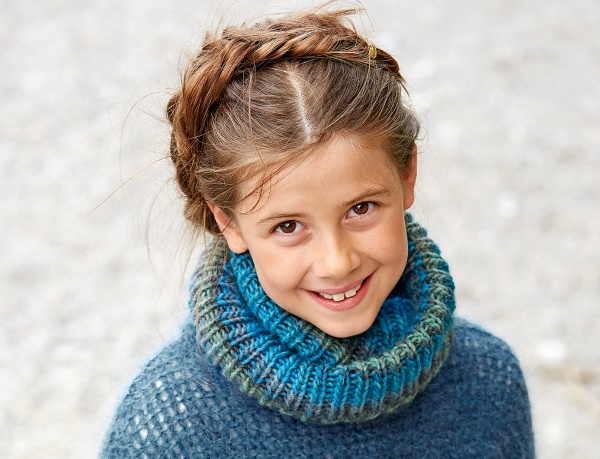
Step-by-step description of the technology:
- The fabric should be knitted as a single piece in circular tiers.
- Cast on 120 sts onto knitting needles and join them into a ring.
- Continue working with ring levels in a rubber band pattern.
- Having knitted 20 cm from the bottom edge, reduce all the cells freely according to the pattern.
Garter stitch
A snood made from thick yarn can be easily knitted using garter stitch for beginner knitters.
To work, you need to select 2 skeins of wool (100g/100m). If the fibers are thinner, then they are woven into 2 threads. You also need to have ring knitting needles No. 6, a marker for weaving, a tape measure and a hook No. 5.
Step-by-step design:
- Cast on 66 sts + 1 st to join the piece into a ring.
- Knit the fabric in a circle with purl stitches, attach a marker at the end of the tier, with which you can determine the beginning of a new tier.
- The next row should be woven using the front method.
- Knit the product in this way to a height of 26-28 rows (approximately 70-76 rows).
- Then finish the work using a hook.
- Hide the remaining ends in the arches of the canvas.
- Finally, carry out wet-heat treatment of the product.
How to knit a snood in two turns with knitting needles
A snood is made of thick yarn with knitting needles in 2 turns. To make the accessory, you need 300 g of milky-colored threads (30% alpaca, 10% wool and 60% acrylic, 150 g - 120 m), as well as ring knitting needles No. 9, 100-120 cm long and a hook No. 4.
Weaving density: 10 cm fits 8 sts. For a collar 140 cm long, you will need to dial 112 sts + 1 st to connect into a circle. The basic ornament is “tangled” or “pearl”, made by alternately knitting 1 front st and 1 out st. In the new tier, shift the pattern by 1 cell.
Procedure:
- Using a simple set, thread the required number of arches onto knitting needles and enclose them in a circle.
- It is recommended to attach a row counter to avoid confusion in your calculations.
- Continue working with the main motif, knitting rows in a checkerboard pattern.
- Knit a panel from the specified amount of yarn.
- Complete the work according to the drawing freely, so that the upper edge looks the same as the lower one.
- The width of the accessory should be 25-28 cm.
- Carefully hide the remaining threads along the side edge using a hook.
- Wash the product by hand, lay it out on a flat surface and dry.
Two-color snood
Snood knitted with thick yarn in different variations. For example, a 2-color model will always be in trend.
Product size:
| Parameters | Size, cm |
| Circle | 152 |
| Width | 27-37 |
To work, you need to buy 200 g of gray and 150 g of pinkish yarn (70% sheep wool and 30% alpaca, 50 g contains 90 m) and knitting needles No. 6.
Knitting density: in a 10x10 sample, made with alternating patterns - 16 sts and 25 rows.
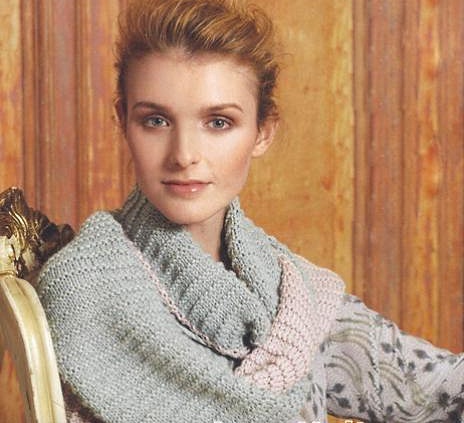
Step-by-step design:
- The main panel is woven by alternating motifs: 1st and 2nd rows of face jersey, and 3rd and 4th rows of garter stitch. Constantly repeat rows 1-4.
- Decorative increases on right edge: edge, 3 sts in garter stitch, knit 1 crossed st from yarn over. On left side: knit 1 crossed st from yarn over, then knit 3 sts in garter stitch, edge.
- Decorative decreases on the right edge: edge, 3 sts in garter stitch, knit 2 sts together with a leftward tilt (drop 1 st in the form of knit stitches, then pull the removed cell through it). From the left edge, knit 2 sts together in the knit stitch, then knit 3 sts in garter stitch, edge.
- Thread 27 sts with grey thread and 16 sts with pinkish yarn onto the knitting needles. You will get 43 sts, knit the 1st tier with a purl st. When changing the shade, the thread should be crossed from the wrong side to prevent the formation of holes.
- Weave the fabric by alternating motifs, making 20 rows of 8x1 sts of decorative increase on both sides of each. 59 sts are formed.
- Then in the next 20th row, decrease by 1x1 st using decorative decreases and after 20 rows, close 7x1 st = 43 sts.
- After the last reduction, perform another 20 rows and finish the work.
- Sew the initial and final levels together.
Openwork
The snood is woven with thick yarn knitting needles using an openwork pattern. For the product, you will need 200 g of gray yarn (65% wool, 35% alpaca, 50 g / 90 m), as well as ring knitting needles No. 5 and for the edge No. 4.
Weaving density: sample 10x10 is made from 19 sts and 25 rows.
Description of technology:
- Cast on the calculated number of stitches on circular knitting needles, a multiple of 13+2 edge links.
- The work is designed in width, for this it is necessary to close the first and last arches into a ring. The length of the snood depends on the total number of cells collected. For the model, it is recommended to make a set from 184 + 2 sts to 208 + 2 sts.
- The first level is knitted in a purl manner, and the second in a front one.
- Knit using this method to the desired distance to create a piping along the edge.
- Then continue working with an openwork ornament. To do this, make 1 yarn over, then remove 1 st as if to knit, do this every 3 links.
- At the beginning of the rapport, you need to remove 1 cell in the form of persons. p., then weave 2 persons. p. together, then throw the dropped arch onto the knitted one. Repeat according to this pattern until the end of the tier.
To knit a snood with an openwork elastic band, you need to have 200 g of thick yarn (wool) and knitting needles No. 5. The model is woven lengthwise, so you can control the size of the product and finish the work at any time. Finally, you need to sew the edges of the clamp together.
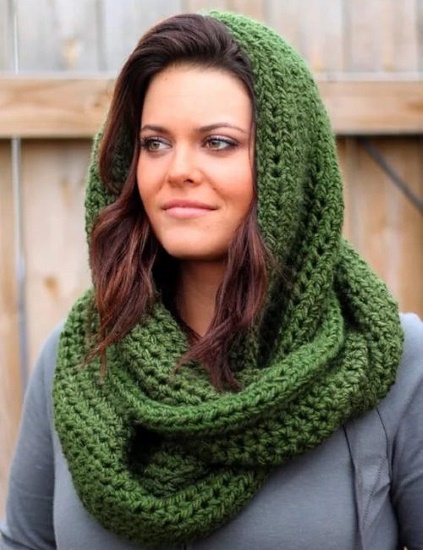
Procedure:
- Cast on 69 sts on knitting rods (the pattern consists of 8 sts, repeated 8 rows). The result is 64+3 sts = 67+2 edges = 69.
- The initial level is knitted using the purl method, then turned to the front, and is not taken into account in the further diagram.
- Continue working with an openwork motif.
- 1st tier (front): edge, * 3 purl sts, knit 2 sts together, 1 yarn over, 1 front, yarn over 1 arch again, knit 2 sts at the same time with a tilt to the left side (drop 1 arch as if knit, make 1 front st and pull it through the slipped link)*. Continue the tier from * to *. When there are 4 sts on the needles, knit 3 of them purlwise and the last one edgewise.
- 2nd level (wrong side): edge, then knit all the cells according to the pattern, at the end make an edge st.
- 3rd row (front of the product): 1 edge, * 3 purl sts, 5 front sts*, repeat from * to * on all remaining loops. When there are 4 sts left on the rods, weave 3 of them purl sts, and design the 4th as an edge.
Then carry out the work according to the following scheme:
| Tier No. | Method of execution |
| 4 | As 2nd row. |
| 5 | As 1st row. |
| 6 | By analogy with the 2nd row. |
| 7 | As 3rd row. |
| 8 | Repeat row 2. |
| 9 | Knit as 1st row. |
A warm, dense, openwork snood can be made from 8-ply threads. For the product, you need 300 g of sectionally dyed yarn (wool - 70%, polyamide - 30%, 150 g contains 320 m) and 150 g of indigo color, a set of hosiery needles and ring rods No. 4.5.
Motifs used:
- Face jersey (alternating face and purl levels). In circular lines continuously weave face sts.
- Ornament for the strips. Alternately design 2 front sts with melange yarn and 2 back sts with blue yarn, while the remaining thread piece is freely pulled along the back side.
- Create the lace according to the pattern, which indicates only the odd ring levels. In the even lines, design the cells according to the pattern, and the yarn overs in the front way. The number of links is a multiple of 6. Constantly repeat from rows 1 to 8 and the rapport.

Weaving density: a 10x10 cm sample contains 21 sts and 33 rows of openwork motif, as well as 20 sts and 28 rows of face jersey.
Registration procedure:
- Cast on 126 sts with blue thread on circular knitting needles and join them into a ring. First weave 1 purl row, then 1 knit row. Then continue working with an openwork motif using multi-colored yarn.
- After 24 cm (about 80 rows), weave a triangle with a blue thread for 51 sts, and set aside the remaining links.
- The triangular figure is designed as follows (in each tier, perform edge stitches on both sides):
| Row No. | Methodology of implementation |
| 1 | Knit 2 sts together with left tilt, throw on 1 snare, 2 sts with left tilt, knit to the last 5 sts with face fabric, then knit 2 sts simultaneously with face st, throw on 1 arch, knit 2 sts together. |
| 2 and the rest of the purl rows. | All links and thrown arches are performed using the purl method. |
| 3-42 p. | Play as 1 and 2 rows. |
| 43 p. | Knit 2 sts together with a left-hand bias, 1 yarn over, knit 3 sts together, then yarn over 1 st, knit 2 sts together at the same time. |
| 45 p. | 1 persons, 3 p. perform together persons. p., again 1 persons. |
| 47 p. | 3 sts. Weave in one go. |
| 49 p. | Z p knit simultaneously knit. p. (without edges). |
Pull the remaining thread through the final cell and tuck it in.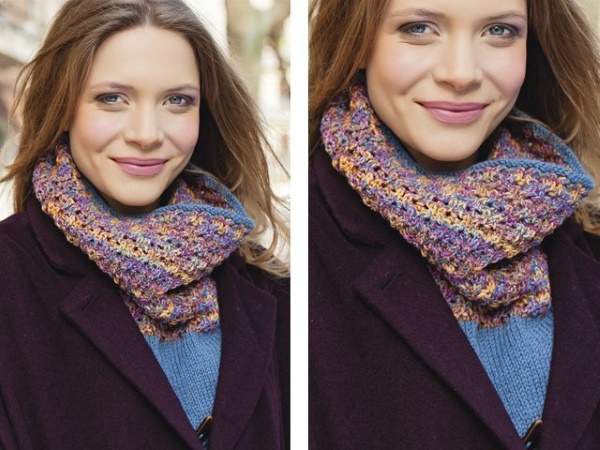
- For the strip, string 97 sts with blue yarn along the edges of the triangle and weave the remaining cells of the product = 172 sts.
- Make 6 ring levels with a plank motif, dispersing the arches so that in the 1st line 2 front sts are at the corner of the triangle.
- In the 2nd circular tier and 3 more times in the following rows, knit from both edges from the 2 central links 1 front crossed st. from the yarn over and insert them into the pattern for the strips. Finish the work with a single-color thread.
- Turn the product inside out so that the triangular figure is on the outer edge. Sew on a button if desired.
Volume
Even inexperienced craftswomen can knit a voluminous snood from thick yarn. The circumference of the accessory is 80 cm, and the height is 30 cm. For work you will need yarn from pure wool (in 100 g - 36 m), ring knitting needles No. 15 with a shortened line, a marker and a thick knitting needle.
The following bindings are used in the work process:
- face jersey (all circular levels are knitted in face stitch);
- purl fabric (in ring weaving all lines are purl);
- Braided pattern (12 sts repeat) should be done in accordance with the provided diagram.
The knitting density is: a 10x10 sample (face jersey) contains 7 sts and 8 rows.
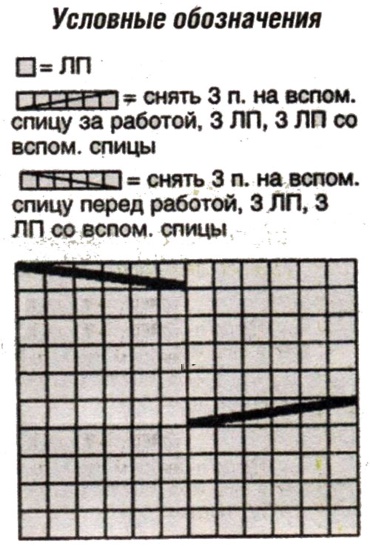 Procedure:
Procedure:
- Cast on 56 sts on knitting needles, then join them into a circle, mark the 1st arch (the beginning of the circle) with a marker and make 1 row using the purl method.
- Then continue working with the “braid” motif, reproducing the 5 row rapport in a circle. At the same time, you need to add 4 sts, forming them evenly (creating 1 front st from the lower draw through after each 14th arch).
- After passing 28 cm (and 2 circular tiers after crossing the "braids"), knit 1 tier of front garter stitch, at the same time decreasing 10 sts evenly (knitting all 5th and 6th arches together in front garter stitch). 50 sts will remain.
- At the end, do 1 row of purl stitch, then 1 row of knit stitch, repeat 1 row of purl stitch again and reduce all the knit stitches.
- Thread the ends of the threads with a hook or a thick needle onto the wrong side of the collar.
To create a universal voluminous warm accessory, you need to select 300 g of thread (75% sheep wool, 25% angora, 100 g/90 m), knitting needles No. 10. Snood parameters: lower width - 71 cm, upper - 61 cm, length - 31 cm.
The product is made with 3 types of braids:
| Number of arches in a harness | Registration procedure |
| 8 | 4 sts. transfer to an additional rod in front of the work, knit 2 front and 2 out., then weave the remaining links - 2 front and 2 out. |
| 7 | Transfer 4 sts to an additional knitting needle at the front of the fabric, knit 2 and purl 1, then shape the removed arches - knit 2 and purl 2. |
| 6 | 3 sts. transfer to an additional tool in front of the product, make 2 front and 1 out. sts, then weave the remaining cells - 2 front and 1 out. |
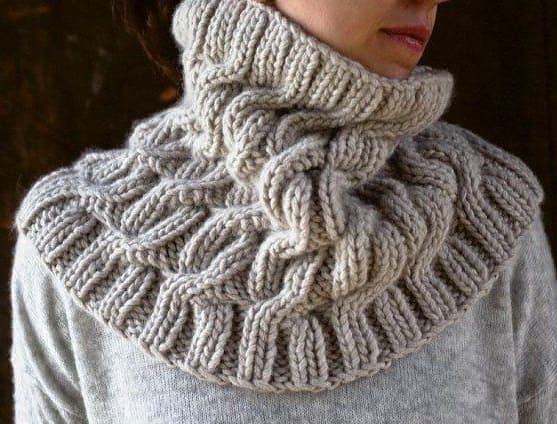
Step-by-step description of making a collar:
- String 112 sts onto the tool, join them into a circle and place a marker at the beginning of the level.
- Next, knit 9 rows with a 2x2 elastic pattern (alternately 2 front and back).
- Row 10: Braid 8 sts in a braid. Form the pattern for Row 14. Then repeat Rows 1 through 10 and Rows 1 through 8.
- Row 29 (decreasing) — * 2 knits, 2 purl, then 2 knits, 2 p. knits together.* from * to * do the entire remaining row.
- Row 30: make a braid on 7 sts.
- from rows 31 to 39 do according to the method: * 2 front, 1 purl, 2 front and 2 purl.
- Row 40 - * 2 persons, 1 out, again 2 persons, 2 persons together. p.*. Continue like this for the entire level.
- Row 41: braid a cord of 6 sts.
- 42-50 p. to design *2 front, 1 back*
Other models
A simple snood can be made from thick yarn in a few hours. The product size is: 150x29 cm. For work you should select 2 skeins of wool (100g/130 m) and knitting needles No. 12.
Motifs used:
- "pearl" ornament. 1st row is knitted by alternating 1 purl st and 1 knit st, in subsequent tiers the pattern is shifted by 1 link;
- The relief strip is made according to the description given.
The weaving provides for the following density: 38 sts, created with a pearl pattern with a relief line, contain 29 cm.
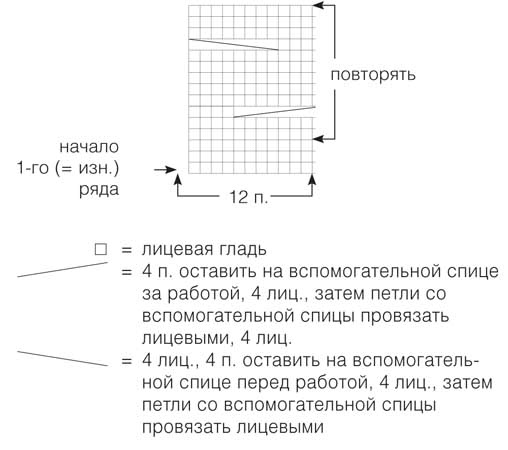
Step-by-step design:
- Cast on 38 sts on knitting needles and start knitting from the purl level according to the pattern: edge, 4 sts of tangled pattern, 12 sts of raised path according to the pattern, then again 4 sts of “pearls” and 12 sts of relief section, finish with 4 sts of pearl pattern and edge.
- After going about 150 cm from the bottom edge, complete the process. The pattern must be followed to the last tier.
- Connect the product along the short edges.
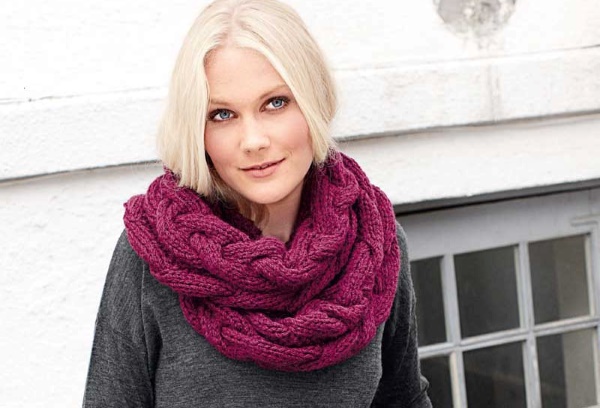
The original snood, knitted with a zigzag pattern, is also used as a hat. For this model you will need 100 g of yellow and dark gray wool yarn (50 g / 175 m), in addition 50 g of gray threads. The tools you will need are knitting needles No. 4.5, as well as a darning needle.
Ornaments used:
- Elastic (double). All levels are knitted as follows: * 1 front st, thread in front of work, then 1 st. drop as in purl knitting, thread at the back of work, * reproduce.
- Face panel (alternating execution of face and back lines).
- The main motif is made on a multiple of 21+1 number of arches. 1st level: 1 knit. p. * 1 snare throw on, 8 knit. p., 2 p. together knit., 2 p. knit with a slope to the left side together (drop 1 p. as in knitting, 1 knit. p., and pull the knitted link through the dropped p.), 8 knit. p., throw on 1 arch, 1 knit. p., from * constantly reproduce. 2nd row. Weave all cells in the purl way. Further work involves repeating the 1st and 2nd rows.
The weave has a density: a 10x10 cm sample contains 23 sts and 25 rows. The product is made with 2-ply fiber.
Registration procedure:
- Cast on 63 sts on knitting rods with contrasting thread and make 4 rows with the front fabric.
- Then continue working with yellow yarn: for the strip, make 3 sts with a rib pattern, 2 sts with knit jersey, 53 sts with the main pattern, 2 sts with knit fabric, then 3 sts with a rib pattern for the piping.
- The colors should be alternated as follows: * 30 rows with yellow thread, 16 rows with dark gray yarn, 30 rows with gray thread*, repeat from * to * 3 more rows. You will get 120 cm from the beginning of the main motif. Then put all the links aside.
- The first 2 rows, decorated with a contrasting thread, are unraveled and the cells are connected with the set aside arches using a knitted seam, connecting the product into a ring.

The jacquard version of the snood with “bumps” along the edges is a smart and warm item. To make it, you will need yarn (70% wool, 30% acrylic, 50 g - 100 m) - 3 skeins of blue shade and 1 skein each of yellow, orange, light green, turquoise and pink. You will also need circular knitting needles No. 5, 80 cm long.
The dimensions of the scarf-collar are 86 cm in circumference and 47 cm in width.
Applied motives:
- Face Jersey (alternate execution of front and back levels).
- "Bumps": 1 st. knit (do not drop the arch from the left part of the knitting tool), yarn over 1 arch and in the same cell make 1 front crossed, 1 yarn over, 1 front st., yarn over 1 more arch, 1 front crossed (remove the link from the left needle) = 7 sts are created from 1 arch. On the resulting loops, knit 4 rows with the front fabric (finish the level with a front tier). Use your finger to give the created bulge a rounded shape and alternately throw the last 6 cells through the 1st st. You will get 1 st again.
- Ornament "vertical stripes": *1 front st with decorative thread, 1 front st with main yarn*, make 20 stripes in width, finish with 1 front st with decorative thread. On the remainder of the cells, weave the pattern according to the chart, using the same shades of thread as in the stripe pattern. Make vertical lines on 21 sts. On the remaining arches = 132 sts (or 11 rapports) – design the ornament according to the chart.
Alternate the shade of the hearts in the following order: * yellow, light green, turquoise, pinkish and orange*, repeat 2 rows from * to *, finish with a yellow tone.
Weaving density: a 10x10 cm sample contains 18 sts and 20 rows.

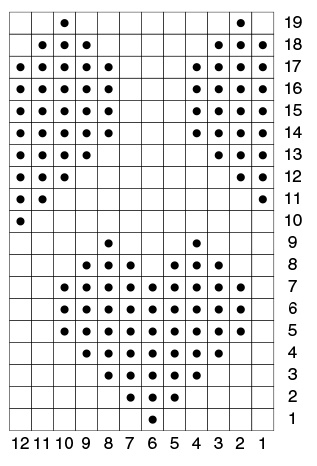
Step-by-step creation of the model:
- Thread 152 sts of blue yarn onto the knitting needles and knit in a circle, starting with the line of “bumps”: * 3 knits, “bump” on the 4th st.*, repeat from * to * the entire row.
- Continue working with the front side facing, adding 1 st at the beginning of the tier. You will get 153 sts.
- Knit with the above pattern of stripes and motifs according to the pattern until the length of the item is 45 cm (including the bobbles).
- Then make another 1 row using the front method. Starting the tier, knit the first 2 loops together.
- Finish the work with a line of “cones” using the above technology (form on every 4th st), reduce the links simultaneously.
A beautiful snood, knitted with thick yarn, is a comfortable and warm item that will come in handy during the cold season. It can be combined with various items of clothing and worn by both adults and children. A beautiful and stylish accessory will create a romantic and relaxed look.
Video on the topic: how to knit a snood with knitting needles from thick yarn
Snood knitted with thick yarn:
